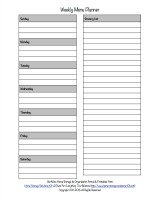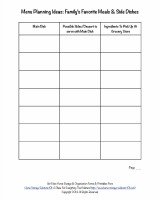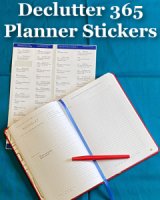
Week #8 Organized Home Challenge
Healthy Meal Planning & Creating Grocery Shopping List
Your challenge this week is to get in the habit of healthy meal planning, and creating a grocery shopping list so you don't forget anything at the store each time you go.

Each of the steps I list below isn't rocket science, but I speak from experience when I say the habit of meal planning can be tough to begin and continue, because it actually involves many different habits.
Although anyone can do this challenge this week, I waited until our last week in the kitchen to do it since many of the other challenges paved the way for this one. That is because it is easier to engage in healthy meal planning when you've:
- Organized your recipes;
- Organized your coupons;
- Know what's in your pantry (such as with a pantry inventory);
- Know what's in your refrigerator and freezer (such as with a freezer inventory); and
- Created and maintain a family calendar
Are you new here? The Healthy Meal Planning And Grocery Shopping List Challenge is part of the 52 Weeks To An Organized Home Challenge. (Click the link to learn how to join us for free for future and past challenges if you aren't already a regular reader).
Now, don't get discouraged if you haven't done any or all of the above mentioned challenges. You can still do meal planning. You'll just find it even easier once you tackle these other areas too, since being organized in them makes it easier to habitually engage in deciding your meals for the week.
Benefits Of Creating A Menu Plan: Why You Should Consider Doing It
Before I dive into the steps of the Healthy Meal Planning And Grocery Shopping List Challenge, I also wanted to briefly discuss why I think planning your meals is such an important part of living an organized life, and why I included it in the Organized Home Challenge.
We've all got to eat meals so it should come as no suprise when dinner rolls around and everyone in the family is hungry. Since this will happen whether you want it to or not, no matter whether you're busy or not, my philosophy is it's better to be prepared than to wing it, since at least prepartion will make the process less stressful, and hopefully even pleasant.
Once you meal plan for a while, as my family has for several years (at least most of the time), you'll notice these additional benefits as well:
- No panic when it's time for dinner, since lots of the thought and preparation (such as grocery shopping, deciding what's for dinner, etc.) is already done by the time its time to begin cooking
- You can focus more on your family's nutrition and dietary needs, as well as their wants and desires in regard to taste
- Helps you save money by not eating out as often, and also planning your purchases around sales and seasonal foods
Step 1: Decide How Often You Want To Meal Plan
There are many different ways to engage in healthy meal planning, and none of them are wrong. All that matters is that whatever method you choose for the process works well for you and your family.
Therefore, the first three steps of this Challenge are actually all the preliminary steps in helping you decide which method you'd like to choose for menu planning.
The first decision to make is how often you want to plan meals, which impacts how often you go to the grocery store, and what types of meals you'll be cooking (all fresh food, versus pantry and freezer staples, for example), among other things.
Some of the main choices are weekly, every two weeks, or monthly. In addition, there is once a month freezer cooking, and cooking with seasonal food.
If you're new to menu planning I would suggest starting with the weekly plan. Even though my family's been planning our meals for years we still use this method since we like to go to the grocery about once a week, so don't think it's a beginners only method.
Instead, I suggest it for beginners, or those getting back into the swing of healthy meal planning because it is easier to plan for a shorter period of time than a longer one. You can always try out a new time span later if you wish to better suit your family's needs and desires.
Step 2: Consider Which Meals (And Snacks) You'll Plan For
The second step of this Challenge is to consider which meals and snacks you wish to plan for.
For example, many people only plan their nightly dinners, and just buy a week's worth of cereal and sandwich fixings for breakfast and lunch each week. On the other hand, others plan all meals, and also snacks for the week. This can be especially important if you've got to pack lunches each day for your family.
Again, there is no right or wrong way to do it. Further, there is no reason why you can't change how you do it at different times during the year, or in various seasons.
For example, during the school year my husband and I tend to only plan dinners, with the idea that we'll eat leftovers from dinner for lunch the next day (planned leftovers). However, during the summer when everyone is home all the time we consider all three meals, using both planned leftovers, and also cooking some breakfasts and lunches to mix it up a bit for everyone.
If you do have to pack lunches each day, for work or school, also make sure to check out this article that can help, about a lunch packing station.

Step 3: Decide If You Want Assistance With Meal Planning, And If So, What Kind?
Finally, the third initial decision you will need to make as part of this Challenge is whether you want to have assistance with your meal planning, or you want to just do it on your own.
There is no right or wrong answer for this decision either. Just what feels right for your family.
Here are the main options to choose from:
Option 1: Do It On Your Own
This method is discussed more thoroughly below in Step 4. Even if you decide to use some assistance, however, you'll most likely need to do some of these steps below anyway, to make sure you take into account the unique circumstances and scheduling issues you've got going on with your family.
Option 2: Use A Meal Planning Service To Tell You Which Meals To Prepare Each Week
If you don't like to think about what to cook, and would rather have someone else do the planning for you, you should consider using a meal planning service.
There are many services available out there, some free and others paid.
One of my favorite meal planning services is Eat At Home Meal Plans. You can read my review of it at the link.

Further, a free meal planning resource that I suggest is from my friend Crystal, from MakeDinnerEasy.com, who provides a free weekly newsletter which gives a meal plan and premade grocery list for you (you can see an example printable weekly dinner menu, plus premade grocery list sample here.
Option 3: Hybrid Method: Use A Program To Help You Plan Meals And Make Your Grocery List
Some people love to be told what to cook each week, where others don't like it at all. They want to make the decision about what they'll prepare and serve their family.
If that sounds like you, but you'd like a bit of help to take the drudgery out of healthy meal planning, I would suggest an online meal planner, like Plan To Eat (click the link to read my review, plus get a free 14 day trial of this program).
The reason that online meal planning services, like Plan To Eat, can be helpful is because they can, depending on the program you choose, help you organize your recipes, plan your meals, and automatically create your grocery shopping list for you each week (Plan To Eat does all those).
That can shorten the amount of time you actually spend on Steps 4-5 of the Challenge below, which can be a good thing if you're short on time.
Several readers have shared which electronic recipe organizer programs they like, and why, if you're interested in using one of them. This also includes several apps, which can help with meal planning, organizing recipes and making your grocery list. Check out all my app recommendations and reviews in the HSS101 App Store (several of them are FREE!)
Step 4: Sit Down And Make Your Healthy Meal Plan
Now that you've made these initial decisions, it's time to actually make your meal plan.
Obviously, if you've chosen to have someone else choose what meals you'll prepare, you won't need to do as many steps as if you're choosing the meals yourself.
Here are the tasks you should complete when making your meal plan:
Step A: Look Briefly To See What Food You've Currently Got On Hand
To save yourself money, and not waste the food you already have, it is best to first take stock of what you've already got in your refrigerator, freezer and pantry, and try to use as many of the ingredients you've already got on hand as possible (especially the ones which may spoil if not used quickly).
You can use these pantry inventory form and freezer inventory form to help you with that task, if you wish.
It's also a similar concept as what we employed earlier in the challenge when we did the Eat From The Pantry & Freezer Challenge.
A reader, Barbara, sent in this photo the left, showing all the places she looks when she is getting her meal plan together, which I thought was a great visualization of this process.
Step B: Look At Your Family Calendar To Recall What Is Going On
Your family is no doubt busy, as most are these days. That's why it's important to have a family calendar where you can keep track of all the activities everyone needs to do, and track everyone's schedule.
Look in the family calendar to see what's happening over the course of the time period where you're planning meals. Look for the following types of things in particular which could impact your meal planning:
- When you or a family member will be away at a meal time
- If you're having guests during a meal time, or otherwise would want to serve your guests some type of food or beverage
- Days when you'll be very busy and will have only a limited amount of time to cook (choose easy meals for these nights, or plan leftovers, etc.)
- Days where you will be home for long periods and could cook more (choose more elaborate meals on these nights, or perhaps double up a recipe for freezing for a busy night later)
- Any sport practices or other events where you are expected to take food or beverages of some type
Step C: Look At The Sales And Circulars For The Week
One of the best ways to save money on groceries is to use your meal plan to help you plan to buy food which is currently on sale, to the extent you haven't already stocked up.
For instance, instead of choosing to have chicken this week, because it sounds good, look at the grocery store circular and see what meat is on sale. If it's beef instead, choose beef meals this week and save the chicken recipes for the week chicken is on sale.
In addition, if you're a couponer, you should use this time to also determine which items you'll add to your menu based on the good deals you can get this way.
Step D: Consider Which Recipes You'd Like To Cook This Week
Taking all of those factors above into consideration, now it's time to choose which recipes and meals you'd like to cook as part of your meal plan.
This is where many people get stuck, but here's my suggestion for getting unstuck. Look at your organized recipes, particularly the group of recipes you've already tried previously and know your family enjoys, to get ideas and inspiration for what you can choose to make now.
I've created a menu planning ideas form you can fill out with your family's favorite main dishes and sides, to give your brain a jog if you need some inspiration as you actually sit down to make your plan week after week.
Further, if you've got a stack of recipes you'd like to try, choose at least one to work into the meal plan so you can try something new.
Step E: Write Your Plan Down
Finally, write your meal plan down on a calendar, a piece of paper, or whatever else you want that you and your family can reference throughout the week (or other time period you're meal planning for).
I've created two different forms that you can choose from for this task, if you'd like. The first is a free printable weekly meal planner template, which includes columns for breakfast, lunch and dinner. The second menu planner form also allows you to plan for a full week of meals, but also contains a place to write your grocery list directly on the page.
I don't think one form is better than the other, but instead just that you should choose the one that works better for the way you prefer to meal plan.
 Weekly Meal Planner Template |
 Menu Planner Form + Grocery List |
Be sure to also write down on your calendar what, if anything, you need to do ahead of time for preparation for any of these meals. For example, if you need to pull meat out of the freezer to thaw, or start a crock pot meal in the morning, make a note of this to make sure you don't forget to do these time sensitive tasks when they need to get done.
Something else you can do is to make sure your family knows the plan you've come up with. To do this you may want to display your plan on a menu board somewhere in your home that everyone can see it.
At the link I've collected lots of ideas from readers who've made such a board to give you ideas you can implement as well. Some of the advantages of a menu board display include reminding yourself at a glance what the plan is, not having to answer the question over and over, "what's for dinner?" and finally, it can get your whole family more involved in the planning process so everyone is pleased with the meals served.
Cook Great Meals In Less Time With An Instant Pot: Free Course To Learn How
Do you have an Instant Pot hiding in your cabinet? Want to learn how to use it? Sign up for Instant Pot School! It's free, and it will help you put that time-saver to work!
Learn more about this free course, and why I'm recommending it in my article all about Instant Pot School.

Step 5: Make Your Grocery Shopping List
Use your recipes and meal plan you've created in Step 4 to make your grocery list, which is Step 5 of Challenge.
Filling out your grocery list shouldn't be difficult once you've created the meal plan, since you just need to jot down any ingredients you need to make the meals you've planned that you don't already have in your home.
In addition, here are some additional tips:
- Make your list all week long, jotting down things you run out of or run low on, as you notice them
- Let your family have access to the list too, so they can also jot things down as they notice what is needed
- Organize your list by aisles of the grocery store to make it easier to see what you need as you pass it, instead of having to double back for a forgotten item
- Note on your list what coupons you've got that you plan to use, so you don't forget to use them and know which size, brand, etc. to buy for the coupon to work
I suggest you make your own customized list, since you'll buy many of the same things each week. However, if you wish to use a form that has already been created for you, you can use this printable grocery list I've created. If you use it, please read the information I've shared about its use on the page, and its limitations as a non-customized form which isn't tailored to your family's unique shopping habits.
In addition, I've created a much shorter one page blank grocery shopping list template you can print, which allows you to group your list according to the major sections of the store. This will hopefully allow you not to have to backtrack for things lower on your list that you forgot when in that section.
If you'd like to see real life examples of other people's running grocery lists, check out this article with tips for how to make a grocery list that works for you.
Step 6: Understand Your Meal Plan Is A Tool For You, But Don't Become Too Rigid With It
At the beginning of this article I explained some of the benefits I've found from meal planning.
However, I've found that people give up on healthy meal planning because they get thrown off from their plan, and therefore find it unworkable.
While I understand getting off track with meal planning, because that has happened in our family quite a number of times, we've always gotten back on the horse, so to speak, with the process because it seems to work well for us.
However, I'm convinced one of the reasons it works well for us is that we're not too rigid about it. Life happens, and sometimes you don't feel like eating what you had planned, or someone gets sick, or is running late, and you've got to make changes to your plans. In fact, I would say it is a rare week that we don't tweak our plan somewhat during the week because of changed circumstances.
Make your meal plans flexible enough that you can switch things around a bit on the fly and you'll still be benefiting from your plan, without worrying about having to stick to it no matter what happens.
Listen To Taylor's Video Tips For This Week's Organized Home Challenge & Declutter 365 Missions
Do you want more in-depth tips and instructions for how to do this week's missions and challenge all about developing the habit of meal planning? If so, I've got recorded video tips from me, Taylor, from the video archives in the Declutter 365 Premium group, all about this week's challenge and missions.
These video tips are available on demand in the archives, once you're a member of the group.
In Week #8's video I discussed the following topics, among others:
- How the mindset of "out of sight, out of mind" causes clutter and stress, and suggested fixes
- Making a lunch packing station
- Meal planning tips
- Grocery shopping list tips
- Declutter 365 missions for week

I suggest watching the video archive for the week, perhaps while you're doing some decluttering or cleaning around your home, before starting the week's missions and Challenge, and then you'll be able to breeze through this week's worth of decluttering missions, as well as organize what's necessary for the 52 Week Organized Home Challenge, based on the advice and instructions within those videos.
It really is like having me, Taylor, available, 24-7, as your decluttering and organizing coach, for every area of your home!
Plus, once you're a member of Declutter 365 Premium you get access to not only this video, but all the videos for the 52 weeks of the year, for 5 years (that's over 260 videos available in the archives!)

Get This Pantry & Food Decluttering Checklist + 32 Other Decluttering Checklists For Your Home
Right now you're decluttering your pantry and other food storage areas, and there's a lot of stuff to declutter in this space.

I've done the hard work of breaking down these tasks into smaller more manageable steps for you, so you don't get overwhelmed or worry you're forgetting a task, and you can go at the pace you want, whether that's fast or slow.
In addition, you can tackle these decluttering tasks in whatever order you want when you use these checklists!

Tell Me How The Healthy Meal Planning And Grocery Shopping List Challenge Is Going For You
I would love to know how this week's Challenge is going for you. You can tell me your progress or give me more ideas for how you've organized this area of your life below in the comments.
I also love before and after pictures of your meal planning systems, and explanations of what you've done to make it work for you and your family.
You can either share what you've done over the course of the week, or if you've already got a system that works for you, you can show me that as well. Submit your pictures (up to four per submission) and/or ideas and get featured in the Hall of Fame. You've worked hard to get organized, so now here's your chance to show off!
Several people have already written in to share with me how they've done these challenge tasks. You can check out the Weekly & Monthly Meal Planner Hall of Fame here.

Sneak Peek For Next Week's Challenge
We're working on our homes slowly, one area at a time, so don't get too distracted from the Healthy Meal Planning And Grocery Shopping List Challenge this week. However, I know people like to plan for what's next, so I'll give you a little sneak peek.
We're finally done with kitchen organization, since we've been working on various aspects of it from Week 1 through now.
The next big section of our homes and lives we'll be working on is about something we need to probably more than we really like, laundry and cleaning. We'll start by organizing the laundry room.
Make Sure You Make The Most Of These 52 Organizing Challenges
Get your copy of the printable one page 52 Week Organized Home Challenge schedule for the year here, so you can see all the challenges we're working on.

Further, if you'd like to join a community of others who are all commmitted to these organizing challenges and corresponding decluttering missions, and want more interaction with me, Taylor, video archives of Taylor providing more tips for each of these challenges and missions, as well as live monthly group coaching sessions focusing on the skills and habits necessary to maintain your home from now on, I'd urge you to join the private and exclusive Declutter 365 Premium Facebook group (you can learn more about it at the link).

In addition, have you gotten your Declutter 365 Products yet, to make sure you can get even more assistance with decluttering and organizing your home this year? There are both free products (like the Declutter 365 calendar, a $20 value), as well as add-ons, such as daily text messages, planner stickers, and a Premium Facebook group, as well as a pack of printabe decluttering checklists.


Some links on this page are affiliate links, meaning that if you purchase a product through them I receive a small commission which helps me provide this information to you for free, plus support my family. My integrity and your satisfaction are very important to me so I only recommend products I would purchase myself, and that I believe would benefit you. To learn more please see my disclosure statement.

Related Pages You May Enjoy
Join The 52 Weeks To An Organized Home Challenge
Printable Errands & Shopping List Template
5 Tips For Time Management For Parents
How To Never Run Out Of Household Items & Grocery Staples {Without Stockpiling}
Go From Healthy Meal Planning And Grocery Shopping Challenge To Home Page
Let's Stay Connected!
Subscribe To Decluttering & Organizing Newsletter
Join Declutter 365 Public Facebook Group (Over 1 Million Members)
Recommended Meal Planning Resources
 Plan To Eat Meal Planner Service
Plan To Eat Meal Planner Service























Share Your Comments, Tips & Ideas
I would love to hear from you, sharing your thoughts, questions, or ideas about this topic, so leave me a comment below. I try to always respond back!